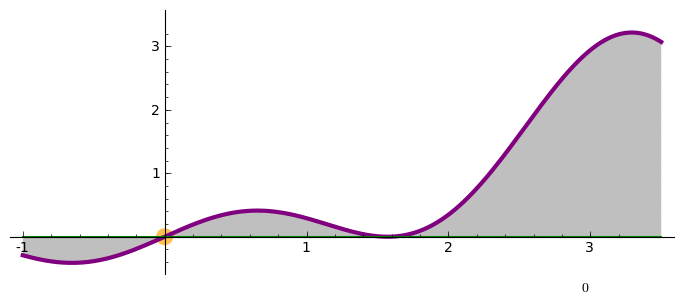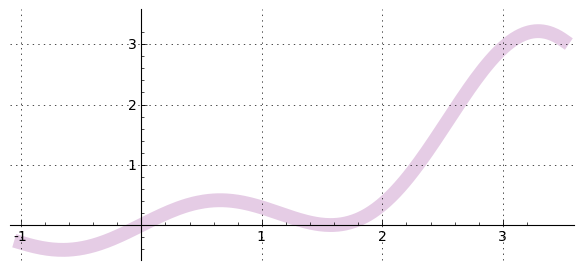An Introduction to Sage
Marco Varisco
Algebra/Topology Seminar, February 7, 2013
- Sage as a (smart) calculator
- A simple algorithm
- Some calculus and pretty pictures
- Solving equations
- Playing with finite groups
- Minimal free resolutions of monomial ideals
Sage as a (smart) calculator
2^16
65536 65536 |
2^160
1461501637330902918203684832716283019655932542976 1461501637330902918203684832716283019655932542976 |
sin(pi/3)
1/2*sqrt(3) 1/2*sqrt(3) |
numerical_approx(sin(pi/3)); n(sin(pi/3)); sin(pi/3).n()
0.866025403784439 0.866025403784439 0.866025403784439 0.866025403784439 0.866025403784439 0.866025403784439 |
n(sin(pi/3), digits=50)
0.86602540378443864676372317075293618347140262690519 0.86602540378443864676372317075293618347140262690519 |
sin(pi/3).n(digits=3)
0.866 0.866 |
a = 12222
|
|
a
12222 12222 |
factor(a)
2 * 3^2 * 7 * 97 2 * 3^2 * 7 * 97 |
a.factor()
2 * 3^2 * 7 * 97 2 * 3^2 * 7 * 97 |
a.prime_divisors()
[2, 3, 7, 97] [2, 3, 7, 97] |
pd = _
pd
[2, 3, 7, 97] [2, 3, 7, 97] |
pd[0]
2 2 |
pd.append('text')
pd
[2, 3, 7, 97, 'text'] [2, 3, 7, 97, 'text'] |
a % 55
12 12 |
a.inverse_mod(55)
23 23 |
a.inverse_mod(56)
Traceback (click to the left of this block for traceback) ... ZeroDivisionError: Inverse does not exist. Traceback (most recent call last):
File "<stdin>", line 1, in <module>
File "_sage_input_19.py", line 10, in <module>
exec compile(u'open("___code___.py","w").write("# -*- coding: utf-8 -*-\\n" + _support_.preparse_worksheet_cell(base64.b64decode("YS5pbnZlcnNlX21vZCg1Nik="),globals())+"\\n"); execfile(os.path.abspath("___code___.py"))
File "", line 1, in <module>
File "/private/var/folders/ml/70rrwtg15qzbrggwjj6s2z800000gn/T/tmpwdhXFx/___code___.py", line 3, in <module>
exec compile(u'a.inverse_mod(_sage_const_56 )
File "", line 1, in <module>
File "integer.pyx", line 5486, in sage.rings.integer.Integer.inverse_mod (sage/rings/integer.c:32847)
ZeroDivisionError: Inverse does not exist.
|
A = mod(a, 55)
|
|
type(a); type(A)
<type 'sage.rings.integer.Integer'> <type 'sage.rings.finite_rings.integer_mod.IntegerMod_int'> <type 'sage.rings.integer.Integer'> <type 'sage.rings.finite_rings.integer_mod.IntegerMod_int'> |
A^-1
23 23 |
a^-1
1/12222 1/12222 |
A.multiplicative_order()
4 4 |
A simple algorithm
def EA(a, b):
while b!=0:
r = a%b
a = b
b = r
return a
|
|
EA(12222, 55)
1 1 |
EA(12222, 550)
2 2 |
def EA(a, b, show=False):
while b!=0:
r = a%b
if show: print (a,b,r)
a = b; b = r
if a<0: a = -a
return a
|
|
EA(12222, 550, show=True)
(12222, 550, 122) (550, 122, 62) (122, 62, 60) (62, 60, 2) (60, 2, 0) 2 (12222, 550, 122) (550, 122, 62) (122, 62, 60) (62, 60, 2) (60, 2, 0) 2 |
EA(12222, 550) == gcd(12222, 550)
True True |
xgcd(12222, 550)
(2, -9, 200) (2, -9, 200) |
d, s, t = xgcd(12222, 550)
|
|
d == s*12222 + t*550
True True |
Some calculus and pretty pictures
f = atan(sqrt(x))
f
arctan(sqrt(x)) arctan(sqrt(x)) |
type(f)
<type 'sage.symbolic.expression.Expression'> <type 'sage.symbolic.expression.Expression'> |
If = f.integrate(x)
If
x*arctan(sqrt(x)) - sqrt(x) + arctan(sqrt(x)) x*arctan(sqrt(x)) - sqrt(x) + arctan(sqrt(x)) |
show(If)
|
latex(If)
x \arctan\left(\sqrt{x}\right) - \sqrt{x} + \arctan\left(\sqrt{x}\right)
x \arctan\left(\sqrt{x}\right) - \sqrt{x} + \arctan\left(\sqrt{x}\right)
|
At this point you should check the Typeset box at the top of this worksheet.
DIf = If.differentiate(x)
f - DIf
|
(f - DIf).simplify_full()
|
f = x*cos(x)^2
f
|
plot(f)
|
|
p = plot(f, xmin=-1, xmax=3.5, ymin=-0.5, ymax=3.5, aspect_ratio=.5, gridlines=True, color='purple', thickness=10, alpha=0.2, figsize=6)
p
|
|
p.save('plot.pdf')
plotf = plot(f, (x,-1,3.5), color='purple', thickness=3)
origin = point((0,0), color='orange', alpha=.7, size=150)
label = 'MacLaurin polynomial of $%s$ of degree'%latex(f)
@interact
def foo(j=slider(0, 20, 1, default=3, label=label)):
Tjf = f.taylor(x, 0, j)
plotTjf = plot(Tjf, (x,-1,3.5), color='green', thickness=1.5, fill=f)
html('$%s$'%latex(Tjf))
show(plotf + plotTjf + origin, ymin=-0.5, ymax=3.5, figsize=[7,3])
Click to the left again to hide and once more to show the dynamic interactive window |
|||||||||||||||||
frames = []
for j in range(-1, 21, 2):
Tjf = f.taylor(x, 0, j)
plotTjf = plot(Tjf, (x,-1,3.5), color='green', thickness=1.5, fill=f)
t = text('$%s$'%latex(Tjf), (3,-0.8), color='black', horizontal_alignment='right')
frames.append(t + plotf + plotTjf + origin)
a = animate(frames, ymin=-0.5, ymax=3.5, figsize=[7,3])
a.show(delay=40)

|
var('x, y, z')
f = x^2 + y^2 + z^2 + cos(4*x) + cos(4*y) + cos(4*z)
c = 0.2
implicit_plot3d(f==c, (x, -1.2, 1.2), (y, -1.2, 1.2), (z, -1.2, 1.2))
|
Sleeping...
 |
implicit_plot3d(f==c, (x, -1.2, 1.2), (y, -1.2, 1.2), (z, -1.2, 1.2), opacity=2/3) + dodecahedron((0,0,0), 1/2, color="purple", opacity=2/3)
|
|
Solving equations
solve(x^3 + 6*x == 20, x)
|
solve(x^4 + 6*x == 20, x)[0]
|
solve(x^5 + 6*x == 20, x)
|
find_root(x^5 + 6*x == 20, 0, 1)
Traceback (click to the left of this block for traceback) ... RuntimeError: f appears to have no zero on the interval Traceback (most recent call last):
File "<stdin>", line 1, in <module>
File "_sage_input_7.py", line 10, in <module>
exec compile(u'open("___code___.py","w").write("# -*- coding: utf-8 -*-\\n" + _support_.preparse_worksheet_cell(base64.b64decode("ZmluZF9yb290KHheNSArIDYqeCA9PSAyMCwgMCwgMSk="),globals())+"\\n"); execfile(os.path.abspath("___code___.py"))
File "", line 1, in <module>
File "/private/var/folders/ml/70rrwtg15qzbrggwjj6s2z800000gn/T/tmpqm_dZy/___code___.py", line 3, in <module>
exec compile(u'find_root(x**_sage_const_5 + _sage_const_6 *x == _sage_const_20 , _sage_const_0 , _sage_const_1 )
File "", line 1, in <module>
File "/Applications/Sage.app/Contents/Resources/sage/local/lib/python2.7/site-packages/sage/numerical/optimize.py", line 76, in find_root
return f.find_root(a=a,b=b,xtol=xtol,rtol=rtol,maxiter=maxiter,full_output=full_output)
File "expression.pyx", line 8806, in sage.symbolic.expression.Expression.find_root (sage/symbolic/expression.cpp:35998)
File "/Applications/Sage.app/Contents/Resources/sage/local/lib/python2.7/site-packages/sage/numerical/optimize.py", line 108, in find_root
raise RuntimeError("f appears to have no zero on the interval")
RuntimeError: f appears to have no zero on the interval
|
find_root(x^5 + 6*x == 20, 0, 2)
|
var('x, y, z')
solve([x + 3*y - 2*z == 5, 3*x + 5*y + 6*z == 7], x, y, z)
|
A = matrix([[1, 3, -2], [3, 5, 6]])
v = vector([5, 7])
A.solve_right(v)
|
A.right_kernel()
|
Av = A.augment(v)
Av.echelon_form()
|
type(Av)
|
Av = Av.change_ring(QQ)
type(Av); Av.echelon_form()
|
Playing with finite groups
Unckeck the Typeset box now, please.
S4 = SymmetricGroup(4)
|
|
S4
Symmetric group of order 4! as a permutation group Symmetric group of order 4! as a permutation group |
show(S4)
|
S4.conjugacy_classes_representatives()
[(), (1,2), (1,2)(3,4), (1,2,3), (1,2,3,4)] [(), (1,2), (1,2)(3,4), (1,2,3), (1,2,3,4)] |
len(S4.conjugacy_classes_representatives()), len(S4.subgroups()), len(S4.conjugacy_classes_subgroups()), len(S4.normal_subgroups())
(5, 30, 11, 4) (5, 30, 11, 4) |
u = S4( (1,2,3,4) )
v = S4( (2,4) )
w = S4( ((1,2),(3,4)) )
|
|
u.order(), u*v, w==u^-1*v
(4, (1,4)(2,3), True) (4, (1,4)(2,3), True) |
G = S4.subgroup([u, v])
|
|
G.order(), G.is_abelian(), G.center().order(), G.is_isomorphic(DihedralGroup(4))
(8, False, 2, True) (8, False, 2, True) |
(1,4) in G, (1,3) in G
(False, True) (False, True) |
G.cayley_graph(generators=[u, v]).show(color_by_label=True)
|
|
G.cayley_graph(generators=[v, w]).show(color_by_label=True)
|
|
T = G.cayley_table()
T
* a b c d e f g h +---------------- a| a b c d e f g h b| b a d c f e h g c| c g a e d h b f d| d h b f c g a e e| e f g h a b c d f| f e h g b a d c g| g c e a h d f b h| h d f b g c e a * a b c d e f g h +---------------- a| a b c d e f g h b| b a d c f e h g c| c g a e d h b f d| d h b f c g a e e| e f g h a b c d f| f e h g b a d c g| g c e a h d f b h| h d f b g c e a |
T.translation()
{'a': (), 'c': (1,2)(3,4), 'b': (2,4), 'e': (1,3), 'd': (1,2,3,4), 'g':
(1,4,3,2), 'f': (1,3)(2,4), 'h': (1,4)(2,3)}
{'a': (), 'c': (1,2)(3,4), 'b': (2,4), 'e': (1,3), 'd': (1,2,3,4), 'g': (1,4,3,2), 'f': (1,3)(2,4), 'h': (1,4)(2,3)}
|
from sage.matrix.operation_table import OperationTable
def commutator(h, g): return h*g*h^-1*g^-1
OperationTable(G, commutator)
. a b c d e f g h +---------------- a| a a a a a a a a b| a a f f a a f f c| a f a f f a f a d| a f f a f a a f e| a a f f a a f f f| a a a a a a a a g| a f f a f a a f h| a f a f f a f a . a b c d e f g h +---------------- a| a a a a a a a a b| a a f f a a f f c| a f a f f a f a d| a f f a f a a f e| a a f f a a f f f| a a a a a a a a g| a f f a f a a f h| a f a f f a f a |
Minimal free resolutions of monomial ideals
R.<a,b,c,d,e> = PolynomialRing(QQ)
I = R.ideal([a*c, b*d, a*e, d*e])
R; I
Multivariate Polynomial Ring in a, b, c, d, e over Rational Field Ideal (a*c, b*d, a*e, d*e) of Multivariate Polynomial Ring in a, b, c, d, e over Rational Field Multivariate Polynomial Ring in a, b, c, d, e over Rational Field Ideal (a*c, b*d, a*e, d*e) of Multivariate Polynomial Ring in a, b, c, d, e over Rational Field |
I.syzygy_module()
[ -e 0 c 0] [ 0 -e 0 b] [ 0 0 -d a] [-b*d a*c 0 0] [ -e 0 c 0] [ 0 -e 0 b] [ 0 0 -d a] [-b*d a*c 0 0] |
singular.mres(I, 0)
[1]: _[1]=d*e _[2]=a*e _[3]=b*d _[4]=a*c [2]: _[1]=c*gen(2)-e*gen(4) _[2]=b*gen(1)-e*gen(3) _[3]=a*gen(1)-d*gen(2) _[4]=a*c*gen(3)-b*d*gen(4) [3]: _[1]=a*c*gen(2)-b*c*gen(3)-b*d*gen(1)+e*gen(4) [4]: _[1]=0 [5]: _[1]=gen(1) [1]: _[1]=d*e _[2]=a*e _[3]=b*d _[4]=a*c [2]: _[1]=c*gen(2)-e*gen(4) _[2]=b*gen(1)-e*gen(3) _[3]=a*gen(1)-d*gen(2) _[4]=a*c*gen(3)-b*d*gen(4) [3]: _[1]=a*c*gen(2)-b*c*gen(3)-b*d*gen(1)+e*gen(4) [4]: _[1]=0 [5]: _[1]=gen(1) |
And don’t forget the SageTeX example! ∞
|
|

.png)
.png)